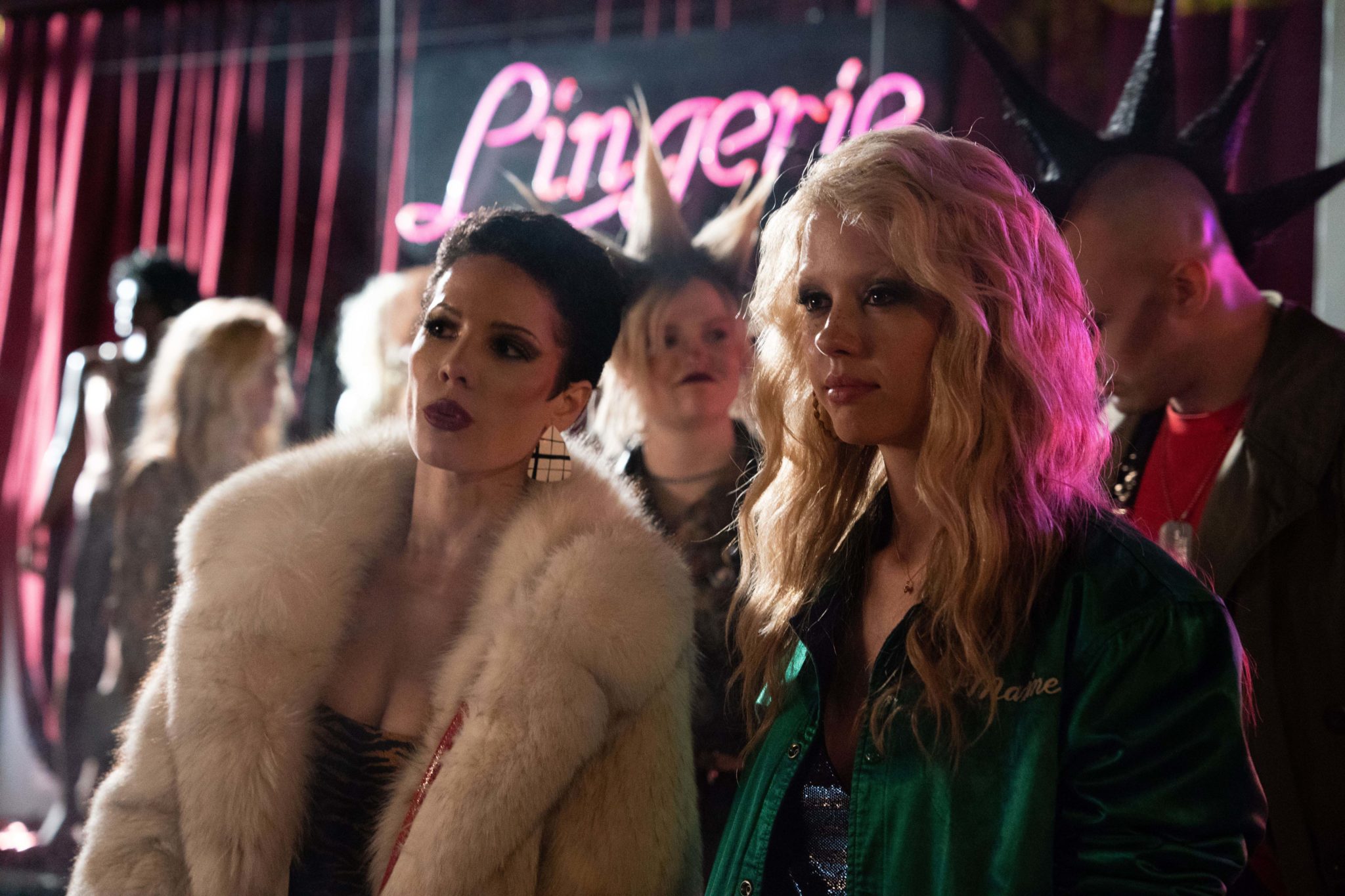- Film And TV
- 19 Jul 24

The MaXXXine trilogy comes to a suitably gory climax in ‘80s Los Angeles with the titular heroine immersed in the city’s infamous porn scene. Director Ti West talks to Roe McDermott about the evolution of the franchise, its star turn Mia Goth and the real-life dangers of the decade it’s set in.
Ti West is Hollywood’s king of scrappy horror. This month sees the release of MaXXXine, the final instalment of West’s porno-slasher-horror trilogy which sees Mia Goth reprise her role as Maxine, an innocent farmgirl turned murderer turned porn actress trying to break into Hollywood.
West’s first film, the ‘70s slasher offering X, was one of the first A24 movies to hit screens in 2022 and took viewers on a wild ride of suspense and violence at a rural Texas farmhouse. Paying homage to The Texas Chainsaw Massacre, X let West play with this love of horror while bringing his trademark plot twists to a story that saw Mia Goth, Jenna Ortega, and Brittany Snow play a group of actors who set out to make an X-rated film in rural Texas under the noses of hermitic hosts. When the couple discover them, the group gradually get picked off one by one. The following year, West released the origin story, Pearl; a slasher horror that showed how Mia Goth’s Pearl became so obsessed with fame – and so full of rage.
Like X, Pearl also wore West’s love for cinema on its blood-soaked sleeve, with its technicolour palette and stylised farmhouse evoking The Wizard Of Oz. The influence of the classic 1939 film is felt in the screenplay, too, as we see this young farm girl escape into her fantasies. Pearl meets characters who have the same qualities as the hollow Tin Man and the Cowardly Lion, and has a truly unforgettable encounter with a scarecrow that we can’t imagine Judy Garland would have approved of.
In MaXXXine, West jumps forward in time, setting his story in 1980s Hollywood, after Maxine’s Texas misadventures. She’s now a hardworking adult film star, determined to break into big screen stardom. But when she finally gets the lead role in a horror sequel with a respected female director (Elizabeth Debicki, The Crown), her past comes to possibly jeopardise her future. A private investigator (Kevin Bacon) has tracked her down and is threatening to reveal her role in the Texas farmhouse bloodbath – but surprisingly, he’s not Maxine’s biggest problem. A serial killer is on the loose and seems to be closing in on Maxine, murdering other porn actresses and taking down her friends, one by one.

Advertisement
MaXXXine is not only a continuation of the development of its lead character, but is also a continuation of West’s love letter to cinema. While X evoked a late-’70s grindhouse aesthetic to celebrate the era when porn was still shot on celluloid, and Pearl incorporated elements reminiscent of a twisted Technicolor Disney musical, MaXXXine is set during the peak of the VHS era. This was a time when low-budget genre films like A Nightmare On Elm Street coexisted with classic Hollywood studio productions such as To Live And Die in L.A., both from 1985. The film sees Maxine experience every facet of ‘80s Los Angeles, from its seedy lap dancing clubs and peep shows to its grimy city streets to the huge, bustling backlots of Hollywood studios. The Chinese Theater, Walk of Fame, and the set of the Bates Motel from Psycho all make crucial appearances in a production that stands out for its multiple locations and sets — and its devotion to the craft and love of moviemaking. Los Angeles in the ‘80s is where dreams could be made or broken, and West wanted to capture the grit as well as the glamour that Maxine dreams of.
“What the other two movies didn’t have was scope,” says West. “MaXXXine is very different from Pearl, and from X, in the sense that we couldn’t repeat ourselves by going to another isolated location, like the farmhouse setting of the predecessors. We needed to go from DIY filmmaking - which was the porn shoot in X - to being in the heart of it all, where we could close out the trilogy in a big, cinematic way. This is ultimately a trilogy about moviemaking, so it felt logical to follow where Maxine would go after X - to be a star in Hollywood.”
The design is impeccable, from the ‘80s costuming and make-up to the film’s soundtrack, all carefully calibrated to immerse the viewer in the decade.
“MaXXXine transports you back to that time and vibe, a sleazier Hollywood that was still very much the Hollywood we know and love today,” says West. “It’s quintessential to the movie - and it’s central to Maxine’s evolution as a character, as she climbs the ladder of success in the industry. We were very meticulous about all the details.”

The canvas West paints for MaXXXine is bigger, brasher, bolder and more baroque on every level, including its social messaging around ‘80s censorship – a theme that feels particularly prescient as we see book bans and moral panics are being weaponsied by Republicans in the United States. While Maxine experiences Los Angeles’ wild nightlife and grapples with the dangers of a serial killer being on the loose, posters, radio reports and news broadcasts in the background hint at the complexity of the time. This was the era of Tipper Gore’s Parents Music Resource Centre which formed in 1985 with the stated goal of increasing parental control over the access of children to music deemed to have violent, drug-related, or sexual themes. You know those Parental Advisory stickers? Thank Tipper Gore. The Parents Music Resource Centre were at the heart of the ‘Filthy 15’ controversy, when songs by Prince, Madonna, Cyndi Lauper and Mötley Crüe were declared obscene.
“This is a slasher trilogy, and it brings some real-life danger to the story because 1985 was a crucial and relevant year in the decade,” says West. “It was the height of the Reagan era, and the Moral Majority, and the Night Stalker killer was on the loose in Southern California. Because of the kinds of movies Maxine has appeared in prior to her big break, she’s in the crosshairs of a cultural moment, where porn movies, and horror movies, and heavy metal music were targeted for being a corruptive influence on American youth.”
Advertisement
West was delighted to work with English actress Mia Goth again, saying that it’s been an honour to watch the now 30-year old actress develop her craft. While audiences have seen Maxine in states of innocence, jealousy, rage and extreme emotion, the woman we see here has grown in self-assurance. Quietly determined, self-sufficient and always in control, Maxine has matured and stepped into her power – just like Mia Goth.
“MaXXXine is an evolution of X and Pearl, a showcase for Mia Goth in ways that differ from the previous movies,” notes Ti West. “Maxine is at a different place in her life, on the cusp of stardom, which echoes Pearl in an unusual way. She’s evolved, like the movies have, and like Mia has in her own stardom. The goal of this trilogy has always been to highlight the craft of filmmaking — one of those crafts being performance. And it’s been exciting to watch Mia over the course of three movies, revealing this constantly evolving diversity in her performance and talent. The thing for both of us was to try and never repeat ourselves across each film.”
• MaXXXine is in cinemas now.










